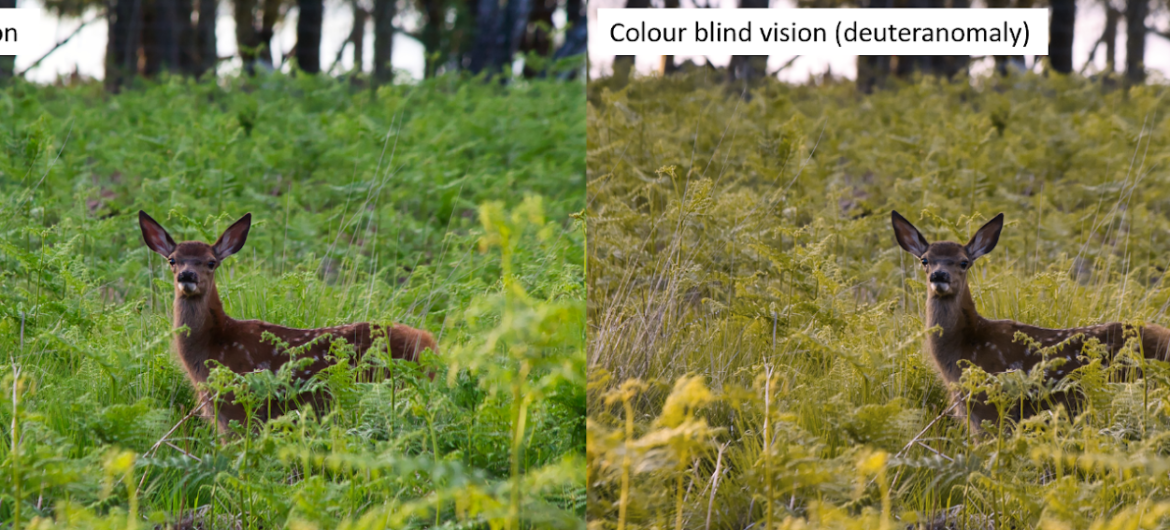Words by Rob Barrie, Science and Technology Editor
It is common knowledge that red and green are the definitive antagonistic colours to represent many aspects in our daily lives. Yet, this acceptance seems extraordinary when 1 in 12 men (and 1 in 200 women) have difficulty distinguishing between the two colours.
I was born with deuteranomaly – the inability to see certain hues of green, due to the lack of certain colour-sensitive cells (cones) in my retina. This also has the added consequence of my eye not being able to differentiate some shades of green from red – hence the collective name red-green colour blindness. The much higher prevalence of colour blindness amongst men is purely down to genetic reasons and the condition is a model example of sex-chromosome linked inheritance (in men it can only be inherited from the mother). But this article will focus on my personal experience of living with colour blindness, rather than the science.
The question of how being colour blind affects me in daily life is difficult to answer. My father is a doctor and, aware of male members in my mother’s side of the family being colour blind, tested me at a relatively young age. Thus, I have never known a time when I wasn’t colour blind. Nevertheless, there are incidences where my lack of cone cells is evident. In university lectures, graphs plotted with red and green points to indicate two pools of data look identical. Cooking red meat is nigh impossible, because the colour of the meat hardly changes. When playing team-based video games, I often shoot players on my team by mistake as I cannot distinguish their green icon from the enemy red! Watching my football team Liverpool F.C., who wear red kits, is tricky. “Seeing” them against a green grass pitch is difficult to say the least. “Who are you passing to?!” is often exclaimed, only to be swiftly followed by an apology when I realise there is in fact a player at the far end of the pitch, perfectly camouflaged in his red jersey. Lastly, unless the words themselves are on the lock, I cannot tell if a toilet is engaged or vacant because the colours look the same – which makes pushing a cubicle door a daily lottery.
As you can tell, one can only find humour during such occasions in that they are harmless scenarios of colour merging. Video games incidentally have colour blind settings, which I utilise. Obviously the same does not exist for live sporting fixtures, but one wonders if teams might adopt more extreme colours to aid colour blind spectators. It must be stated I am yet to encounter a situation of mistaking colours which either puts myself or others at harm. The green of a traffic light, for example, has added blue hues to make differentiation from red easier. Society therefore does have provisions in place, but, in truth, they are sparse. The London Underground map, for example, though beautiful, is possibly the least colour blind friendly item in existence.
I have a suspicion that society’s disregard for colour blindness is in part due to lack of education at school (and, more generally, in wider life). It’s rarely given its due platform – and if it is talked about in a biology classroom, it merely serves as a vehicle to explain genetic inheritance. The resulting hurdles that individuals with colour blindness face are ignored. The ignorance of this condition bears itself most evidently in social conversation. If and when the topic arises, the usual, monotonous questions are directed to me. What colour is this pencil? What colour is that folder? Can you see grass? Like a lab rat being asked to complete behavioural tasks, it quickly becomes tedious. I understood the interest amongst peers as a child, but it was bemusing, yet simultaneously insightful, that the condition is still so poorly understood in my adult life. I do not, it must be said, place blame on my peers, but instead on poor scientific communication of the sociological consequences of it.
Despite all of this, I wouldn’t change my vision. If corrective retinal surgery were to become available, I would decline it. I find it fascinating that I see the world in a different way to others and that, by having different eyes, my brain extracts and decodes wavelengths of light in its own special way. As a lover of wildlife photography, I assume my photographs are unique in their colour composition because I will naturally find different lighting angles to others. It’s why when I watch the sun slowly set over countryside fields on a warm summer evening, I know I’m seeing a completely unique sunset to those around me – and there’s something rather magical about that.


